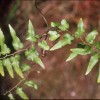 Native to Africa, Asia, and Australia, Old World climbing fern (OWCF) is a newcomer to Florida that has spread at an alarming rate since its introduction. The Florida Exotic Pest Plant Council considers Old World climbing fern to be invasive. It’s also regulated by laws of the Florida Department of Agriculture and Consumer Services (FDACS) as a Florida Noxious Weed and by the United States Department of Agriculture (USDA) as a Federal Noxious Weed. It may be the most serious threat to Florida’s natural areas. This 6-page fact sheet was written by Kenneth A. Langeland and Jeffery Hutchinson, and published by the UF Department of Agronomy, February 2013.
Native to Africa, Asia, and Australia, Old World climbing fern (OWCF) is a newcomer to Florida that has spread at an alarming rate since its introduction. The Florida Exotic Pest Plant Council considers Old World climbing fern to be invasive. It’s also regulated by laws of the Florida Department of Agriculture and Consumer Services (FDACS) as a Florida Noxious Weed and by the United States Department of Agriculture (USDA) as a Federal Noxious Weed. It may be the most serious threat to Florida’s natural areas. This 6-page fact sheet was written by Kenneth A. Langeland and Jeffery Hutchinson, and published by the UF Department of Agronomy, February 2013.
http://edis.ifas.ufl.edu/ag122
Category: Environment
Florida's Established Arthropod Weed Biological Control Agents and Their Targets (ENY853/IN779)
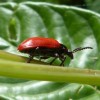 Around 5% of the plant species deliberately introduced into Florida for crop production and horticultural uses have invaded sensitive aquatic and terrestrial natural areas as well as improved pastures. One of the reasons they become invasive is they lack the natural enemies that limit their reproduction. Biological control reunites these natural enemies (usually arthropods) with their host plants to selectively weaken and suppress the invasive weeds. This 3-page fact sheet was written by J. P. Cuda and J. H. Frank, and published by the UF Department of Entomology and Nematology, October 2013.
Around 5% of the plant species deliberately introduced into Florida for crop production and horticultural uses have invaded sensitive aquatic and terrestrial natural areas as well as improved pastures. One of the reasons they become invasive is they lack the natural enemies that limit their reproduction. Biological control reunites these natural enemies (usually arthropods) with their host plants to selectively weaken and suppress the invasive weeds. This 3-page fact sheet was written by J. P. Cuda and J. H. Frank, and published by the UF Department of Entomology and Nematology, October 2013.
http://edis.ifas.ufl.edu/in779
Wildland-Urban Interface: Key Issues (FOR202/FR264)
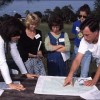 A result of the influx of new residents to the South is an expansion of urban areas into forests and other natural areas, creating areas referred to as the wildland-urban interface. Interface issues of most concern vary from state to state, but some key issues are consistent across the South. the US Forest Service conducted a series of focus groups in 2000. Key issues gleaned from those focus groups and other related sources are described in this 5-page fact sheet written by L. Annie Hermansen-Baez, Jennifer Seitz, and Martha C. Monroe, and published by the UF Department of School of Forest Resources and Conservation, February 2013.
A result of the influx of new residents to the South is an expansion of urban areas into forests and other natural areas, creating areas referred to as the wildland-urban interface. Interface issues of most concern vary from state to state, but some key issues are consistent across the South. the US Forest Service conducted a series of focus groups in 2000. Key issues gleaned from those focus groups and other related sources are described in this 5-page fact sheet written by L. Annie Hermansen-Baez, Jennifer Seitz, and Martha C. Monroe, and published by the UF Department of School of Forest Resources and Conservation, February 2013.
http://edis.ifas.ufl.edu/fr264
A Multi-Disciplinary Review of Current Sea-Level Change Research in Florida (TP193/SG125)
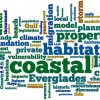 Sea-level rise is an issue of paramount importance for the state of Florida due to its lengthy coastline, low relief, high coastal population density, ecologically and economically vital beaches, estuaries, and wetlands, and porous limestone geology. The rate of sea-level rise in Florida generally follows the global average (~3 mm per year) and is slowly gaining public attention as a significant threat to the natural and socioeconomic future of the state. This 18-page multi-disciplinary review provides an annotated bibliographic summary of current peer-reviewed literature regarding sea-level rise in Florida. Written by Anna Cathey Linhoss, Lisa Gardner Chambers, Kevin Wozniak, and Tom Ankersen, and published by the UF Department of Sea Grant, February 2013.
Sea-level rise is an issue of paramount importance for the state of Florida due to its lengthy coastline, low relief, high coastal population density, ecologically and economically vital beaches, estuaries, and wetlands, and porous limestone geology. The rate of sea-level rise in Florida generally follows the global average (~3 mm per year) and is slowly gaining public attention as a significant threat to the natural and socioeconomic future of the state. This 18-page multi-disciplinary review provides an annotated bibliographic summary of current peer-reviewed literature regarding sea-level rise in Florida. Written by Anna Cathey Linhoss, Lisa Gardner Chambers, Kevin Wozniak, and Tom Ankersen, and published by the UF Department of Sea Grant, February 2013.
http://edis.ifas.ufl.edu/sg125
Grass Carp: A Fish for Biological Management of Hydrilla and Other Aquatic Weeds in Florida (BUL867/FA043)
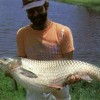 Abundant growth of aquatic plants causes serious problems in ponds, lakes, rivers, and irrigation and drainage throughout Florida. In some situations, native aquatic plants become weeds, but most often exotic plants introduced from areas outside the state flourish under the favorable growing conditions found in Florida. Long-term economical solutions to Florida’s aquatic weed problems have been elusive and there is a need for control techniques to alleviate aquatic weed problems. This 6-page fact sheet provides information on a biological method, the grass carp, for management of some of Florida’s aquatic weed problems. Written by David L. Sutton and Vernon V. Vandiver, Jr., and published by the UF Department of Fisheries and Aquatic Sciences, November 2013.
Abundant growth of aquatic plants causes serious problems in ponds, lakes, rivers, and irrigation and drainage throughout Florida. In some situations, native aquatic plants become weeds, but most often exotic plants introduced from areas outside the state flourish under the favorable growing conditions found in Florida. Long-term economical solutions to Florida’s aquatic weed problems have been elusive and there is a need for control techniques to alleviate aquatic weed problems. This 6-page fact sheet provides information on a biological method, the grass carp, for management of some of Florida’s aquatic weed problems. Written by David L. Sutton and Vernon V. Vandiver, Jr., and published by the UF Department of Fisheries and Aquatic Sciences, November 2013.
http://edis.ifas.ufl.edu/fa043
Tropical Soda Apple Leaf Beetle, Gratiana boliviana Spaeth (Insecta: Coleoptera: Chrysomelidae: Cassidinae) (EENY543/IN974)
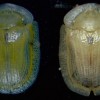 Tropical soda apple is a prickly shrub native to South America that is a major problem in pastures and conservation areas. So a multi-agency program supported the rearing, distribution, and release of more than 250,000 tropical soda apple leaf beetles across Florida from 2003 to 2011. This 4-page fact sheet was written by Rodrigo Diaz, William A. Overholt, Ken Hibbard, and Julio Medal, and published by the UF Department of Entomology and Nematology, January 2013.
Tropical soda apple is a prickly shrub native to South America that is a major problem in pastures and conservation areas. So a multi-agency program supported the rearing, distribution, and release of more than 250,000 tropical soda apple leaf beetles across Florida from 2003 to 2011. This 4-page fact sheet was written by Rodrigo Diaz, William A. Overholt, Ken Hibbard, and Julio Medal, and published by the UF Department of Entomology and Nematology, January 2013.
http://edis.ifas.ufl.edu/in974
Tips for Integrating Land and Wildlife Management: Deer in Ranchlands (WEC330/UW375)
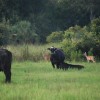 In addition to having generally low-quality foods, ranchlands often have a low diversity of food sources, further reducing the quality of habitat for deer. Ranchland management for deer should therefore focus on providing a diversity of abundant, high-quality foods. This 2-page fact sheet provides some deer habitat improvement tips that focus primarily on raising the quality of deer forage but that also will help you grow better cover by improving plant diversity and productivity. Written by William M. Giuliano, John M. Olson, and Cailey Thomas, and published by the UF Department of Wildlife Ecology and Conservation, January 2013.
In addition to having generally low-quality foods, ranchlands often have a low diversity of food sources, further reducing the quality of habitat for deer. Ranchland management for deer should therefore focus on providing a diversity of abundant, high-quality foods. This 2-page fact sheet provides some deer habitat improvement tips that focus primarily on raising the quality of deer forage but that also will help you grow better cover by improving plant diversity and productivity. Written by William M. Giuliano, John M. Olson, and Cailey Thomas, and published by the UF Department of Wildlife Ecology and Conservation, January 2013.
http://edis.ifas.ufl.edu/uw375
Natural Area Weeds: Skunkvine (Paederia foetida) (SSAGR80/WG208)
 Native to eastern and southern Asia, skunkvine is an invasive plant species introduced to the USDA Field Station near Brooksville before 1897. It has been included on the Florida Exotic Pest Plant Council List of Invasive Species as a Category I, defined as “species that are invading and disrupting native plant communities in Florida.” It was added to the Florida Noxious Weed List in 1999, making it illegal to possess, move, or release in Florida. This 3-page fact sheet was written by K. A. Langeland, R. K. Stocker, and D. M. Brazis, and published by the UF Department of Agronomy, February 2013.
Native to eastern and southern Asia, skunkvine is an invasive plant species introduced to the USDA Field Station near Brooksville before 1897. It has been included on the Florida Exotic Pest Plant Council List of Invasive Species as a Category I, defined as “species that are invading and disrupting native plant communities in Florida.” It was added to the Florida Noxious Weed List in 1999, making it illegal to possess, move, or release in Florida. This 3-page fact sheet was written by K. A. Langeland, R. K. Stocker, and D. M. Brazis, and published by the UF Department of Agronomy, February 2013.
http://edis.ifas.ufl.edu/wg208
Freshwater Turtles of Belize (WEC328/UW373)
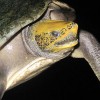 Belize, a country rich in natural resources and diverse wildlife, is home to nine species of freshwater turtles. Among these is the critically endangered hicatee, which has been eliminated in most of its range as a result of hunting and habitat loss. Freshwater turtles live in rivers, creeks, and lagoons, and build their nests on the banks. They eat a variety of plants, aquatic vegetation, and fruits. However, little is known about Belize’s unique turtle species. This 2-page fact sheet will help people identify, understand, and conserve these treasured resources. Written by Venetia Briggs, Lauren Watine, Dustin Smith, Robin Bijlani, Rebecca Harvey, William Giuliano, and Frank Mazzotti, and published by the UF Department of Wildlife Ecology and Conservation, January 2013.
Belize, a country rich in natural resources and diverse wildlife, is home to nine species of freshwater turtles. Among these is the critically endangered hicatee, which has been eliminated in most of its range as a result of hunting and habitat loss. Freshwater turtles live in rivers, creeks, and lagoons, and build their nests on the banks. They eat a variety of plants, aquatic vegetation, and fruits. However, little is known about Belize’s unique turtle species. This 2-page fact sheet will help people identify, understand, and conserve these treasured resources. Written by Venetia Briggs, Lauren Watine, Dustin Smith, Robin Bijlani, Rebecca Harvey, William Giuliano, and Frank Mazzotti, and published by the UF Department of Wildlife Ecology and Conservation, January 2013.
http://edis.ifas.ufl.edu/uw373
Tips for Integrating Land and Wildlife Management: Deer in Forests (WEC329/UW374)
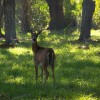 Prized by hunters and wildlife enthusiasts alike, white-tailed deer are a popular species found throughout Florida. As such, they are often the focus of management for landowners, managers, and lessees who want to improve deer populations while maintaining other land uses such as timber production. This 2-page fact sheet provides some deer habitat improvement tips that focus primarily on raising the quality of deer forage but that also will help you grow better cover by improving plant diversity and productivity. Written by William M. Giuliano, John M. Olson, and Cailey Thomas, and published by the UF Department of Wildlife Ecology and Conservation, January 2013.
Prized by hunters and wildlife enthusiasts alike, white-tailed deer are a popular species found throughout Florida. As such, they are often the focus of management for landowners, managers, and lessees who want to improve deer populations while maintaining other land uses such as timber production. This 2-page fact sheet provides some deer habitat improvement tips that focus primarily on raising the quality of deer forage but that also will help you grow better cover by improving plant diversity and productivity. Written by William M. Giuliano, John M. Olson, and Cailey Thomas, and published by the UF Department of Wildlife Ecology and Conservation, January 2013.
http://edis.ifas.ufl.edu/uw374
Tips for Integrating Land and Wildlife Management: Quail and Timber (WEC331/UW376)
 In Florida, changes in forest management practices during the past 50+ years have led to declines in quail habitat and populations. Important changes involve the use of fire and conversion of native forests to commercial pine plantations. A lack of fire and other disturbance has often led to closed-canopy forests with dense undergrowth that lack important quail habitat components. This 2-page fact sheet provides several quail habitat improvement tips that focus on diversifying the plant species and structural composition and increasing early successional communities dominated by herbaceous plants. Written by William M. Giuliano and Lauren Watine, and published by the UF Department of Wildlife Ecology and Conservation, January 2013.
In Florida, changes in forest management practices during the past 50+ years have led to declines in quail habitat and populations. Important changes involve the use of fire and conversion of native forests to commercial pine plantations. A lack of fire and other disturbance has often led to closed-canopy forests with dense undergrowth that lack important quail habitat components. This 2-page fact sheet provides several quail habitat improvement tips that focus on diversifying the plant species and structural composition and increasing early successional communities dominated by herbaceous plants. Written by William M. Giuliano and Lauren Watine, and published by the UF Department of Wildlife Ecology and Conservation, January 2013.
http://edis.ifas.ufl.edu/uw376
Environmental Education Resources from Federal and State Agencies (FOR100/FR128)
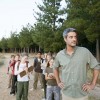 Going on a field trip? Want a spiffy new poster? Looking for a guest speaker? Or do you just need to know more about wildland fire, endangered species, coastal management, or invasive exotics? Many agencies are available to provide information, share resources, support field trips, and contribute to your environmental education programming. This 8-page fact sheet explores federal and state agencies in Florida with major educational resources. Written by Martha C. Monroe and Alison W. Bowers, and published by the UF Department of School of Forest Resources and Conservation, December 2012.
Going on a field trip? Want a spiffy new poster? Looking for a guest speaker? Or do you just need to know more about wildland fire, endangered species, coastal management, or invasive exotics? Many agencies are available to provide information, share resources, support field trips, and contribute to your environmental education programming. This 8-page fact sheet explores federal and state agencies in Florida with major educational resources. Written by Martha C. Monroe and Alison W. Bowers, and published by the UF Department of School of Forest Resources and Conservation, December 2012.
http://edis.ifas.ufl.edu/fr128
Native Pitcherplants of Florida (WEC333/UW378)
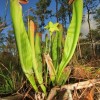 Pitcherplants are perennial plants with groups of leaves modified into traps or pitchers. They have tubular leaves with lids or hoods at the top that secrete nectar to attract prey. Once insects are on the lip of the pitcher, they can slip on the waxy opening and fall into the plant. This 5-page fact sheet provides descriptions of the ranges, appearance, and flowering of the six pitcherplant species native to Florida. Written by Megan E. Brown and Debbie L. Miller, and published by the UF Department of Wildlife Ecology and Conservation, January 2013.
Pitcherplants are perennial plants with groups of leaves modified into traps or pitchers. They have tubular leaves with lids or hoods at the top that secrete nectar to attract prey. Once insects are on the lip of the pitcher, they can slip on the waxy opening and fall into the plant. This 5-page fact sheet provides descriptions of the ranges, appearance, and flowering of the six pitcherplant species native to Florida. Written by Megan E. Brown and Debbie L. Miller, and published by the UF Department of Wildlife Ecology and Conservation, January 2013.
http://edis.ifas.ufl.edu/uw378
Enemigos naturales y control biologico (ENY866/IN977)
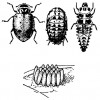 Hay muchos insectos benéficos pero solamente hay algunos que son enemigos naturales de plagas. Los enemigos naturales más comunes de encontrar son: mariquitas/tortolitas, crisopas, antocóridos (Orius), ligaéidos, sírfidos, avispas de agallas, hormigas, avispas parasíticas, moscas parasíticas y ácaros depredadores. La importancia relativa varía de acuerdo con cada insecto plaga, el hábitat y la estación o época del año. This 7-page fact sheet was written by Hugh A. Smith y John L. Capinera, traducido por Ana Lucrecia MacVean, and published by the UF Department of Entomology and Nematology, January 2013.
Hay muchos insectos benéficos pero solamente hay algunos que son enemigos naturales de plagas. Los enemigos naturales más comunes de encontrar son: mariquitas/tortolitas, crisopas, antocóridos (Orius), ligaéidos, sírfidos, avispas de agallas, hormigas, avispas parasíticas, moscas parasíticas y ácaros depredadores. La importancia relativa varía de acuerdo con cada insecto plaga, el hábitat y la estación o época del año. This 7-page fact sheet was written by Hugh A. Smith y John L. Capinera, traducido por Ana Lucrecia MacVean, and published by the UF Department of Entomology and Nematology, January 2013.
http://edis.ifas.ufl.edu/in977
Air Potato Leaf Beetle (Suggested Common Name), Lilioceris cheni Gressitt and Kimoto (Insecta: Coleoptera: Chrysomelidae: Criocerinae) (EENY547/IN972)
 This leaf feeding beetle was recently introduced into Florida from China for biological control of air potato. This 4-page fact sheet provides information on the distribution, appearance, life cycle, host range and importance of the beetle. Written by Entomology and Nematology, and published by the UF Department of Ted D. Center and William A. Overholt, January 2013.
This leaf feeding beetle was recently introduced into Florida from China for biological control of air potato. This 4-page fact sheet provides information on the distribution, appearance, life cycle, host range and importance of the beetle. Written by Entomology and Nematology, and published by the UF Department of Ted D. Center and William A. Overholt, January 2013.
http://edis.ifas.ufl.edu/in972
Tips for Integrating Land and Wildlife Management: Quail in Cattle Country (WEC332/UW377)
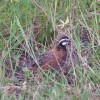 This 2-page fact sheet provides specific tips to improve quail habitat in cattle country that focus on diversifying the plant species and structural composition and increasing early successional communities dominated by herbaceous plants. Written by William M. Giuliano and Lauren Watine, and published by the UF Department of Wildlife Ecology and Conservation, January 2013.
This 2-page fact sheet provides specific tips to improve quail habitat in cattle country that focus on diversifying the plant species and structural composition and increasing early successional communities dominated by herbaceous plants. Written by William M. Giuliano and Lauren Watine, and published by the UF Department of Wildlife Ecology and Conservation, January 2013.
http://edis.ifas.ufl.edu/uw377
Puss Caterpillar (Larva), Southern Flannel Moth (Adult), Megalopyge opercularis (J. E. Smith 1797) (Insecta: Lepidoptera: Zygaenoidea: Megalopygidae) (EENY545/IN976)
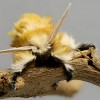 The southern flannel moth is an attractive small moth that is best-known because of its larva, the puss caterpillar, which is one of the most venomous caterpillars in the United States. This 12-page fact sheet was written by Donald W. Hall, and published by the UF Department of Entomology and Nematology, January 2013.
The southern flannel moth is an attractive small moth that is best-known because of its larva, the puss caterpillar, which is one of the most venomous caterpillars in the United States. This 12-page fact sheet was written by Donald W. Hall, and published by the UF Department of Entomology and Nematology, January 2013.
http://edis.ifas.ufl.edu/in976
Spiral Nematode, Helicotylenchus pseudorobustus (Steiner, 1941) Golden, 1956 (Nematoda: Tylenchida: Hoplolaimidae) (EENY544/IN973)
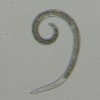 Spiral nematodes of the genus Helicotylenchus are among the most ubiquitous plant-parasitic nematodes worldwide. Helicotylenchus pseudorobustus is a species common in Florida and the southeastern United States and is frequently found associated with turfgrasses and other grass hosts in the region. On most plants, it is not considered particularly damaging, but recent research has shown that this species suppresses growth of certain turfgrass hosts. Seashore paspalum, a turfgrass used in tropical and subtropical regions, is particularly susceptible to infestation. This 4-page fact sheet was written by William T. Crow, and published by the UF Department of Entomology and Nematology, January 2013.
Spiral nematodes of the genus Helicotylenchus are among the most ubiquitous plant-parasitic nematodes worldwide. Helicotylenchus pseudorobustus is a species common in Florida and the southeastern United States and is frequently found associated with turfgrasses and other grass hosts in the region. On most plants, it is not considered particularly damaging, but recent research has shown that this species suppresses growth of certain turfgrass hosts. Seashore paspalum, a turfgrass used in tropical and subtropical regions, is particularly susceptible to infestation. This 4-page fact sheet was written by William T. Crow, and published by the UF Department of Entomology and Nematology, January 2013.
http://edis.ifas.ufl.edu/in973
A mosquito Psorophora ciliata (Fabricius) (Insecta: Diptera: Culicidae) (EENY540/IN967)
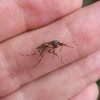 Psorophora ciliata (Fabricius) is a large mosquito that has developed an outsized reputation because of its relatively intimidating heft and persistent biting behavior, including anecdotal historical accounts of its legendary aggressiveness and ‘frightening appearance’. This 6-page fact sheet was written by Ephraim V. Ragasa and Phillip E. Kaufman, and published by the UF Department of Entomology and Nematology, October 2012.
Psorophora ciliata (Fabricius) is a large mosquito that has developed an outsized reputation because of its relatively intimidating heft and persistent biting behavior, including anecdotal historical accounts of its legendary aggressiveness and ‘frightening appearance’. This 6-page fact sheet was written by Ephraim V. Ragasa and Phillip E. Kaufman, and published by the UF Department of Entomology and Nematology, October 2012.
http://edis.ifas.ufl.edu/in967
A Colonial tentweb orbweaver Cyrtophora citricola (EENY535/IN966)
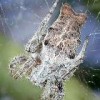 Few species of spiders can be considered truly social, but a greater number of species, particularly web-building spiders, live in close proximity to one another. One species which has become highly successful through a lifestyle of colonial aggregation is the orbweaver Cyrtophora citricola Forskål. This 6-page fact sheet was written by Lionel A. Stange, and published by the UF Department of Entomology and Nematology, October 2012.
Few species of spiders can be considered truly social, but a greater number of species, particularly web-building spiders, live in close proximity to one another. One species which has become highly successful through a lifestyle of colonial aggregation is the orbweaver Cyrtophora citricola Forskål. This 6-page fact sheet was written by Lionel A. Stange, and published by the UF Department of Entomology and Nematology, October 2012.
http://edis.ifas.ufl.edu/in966